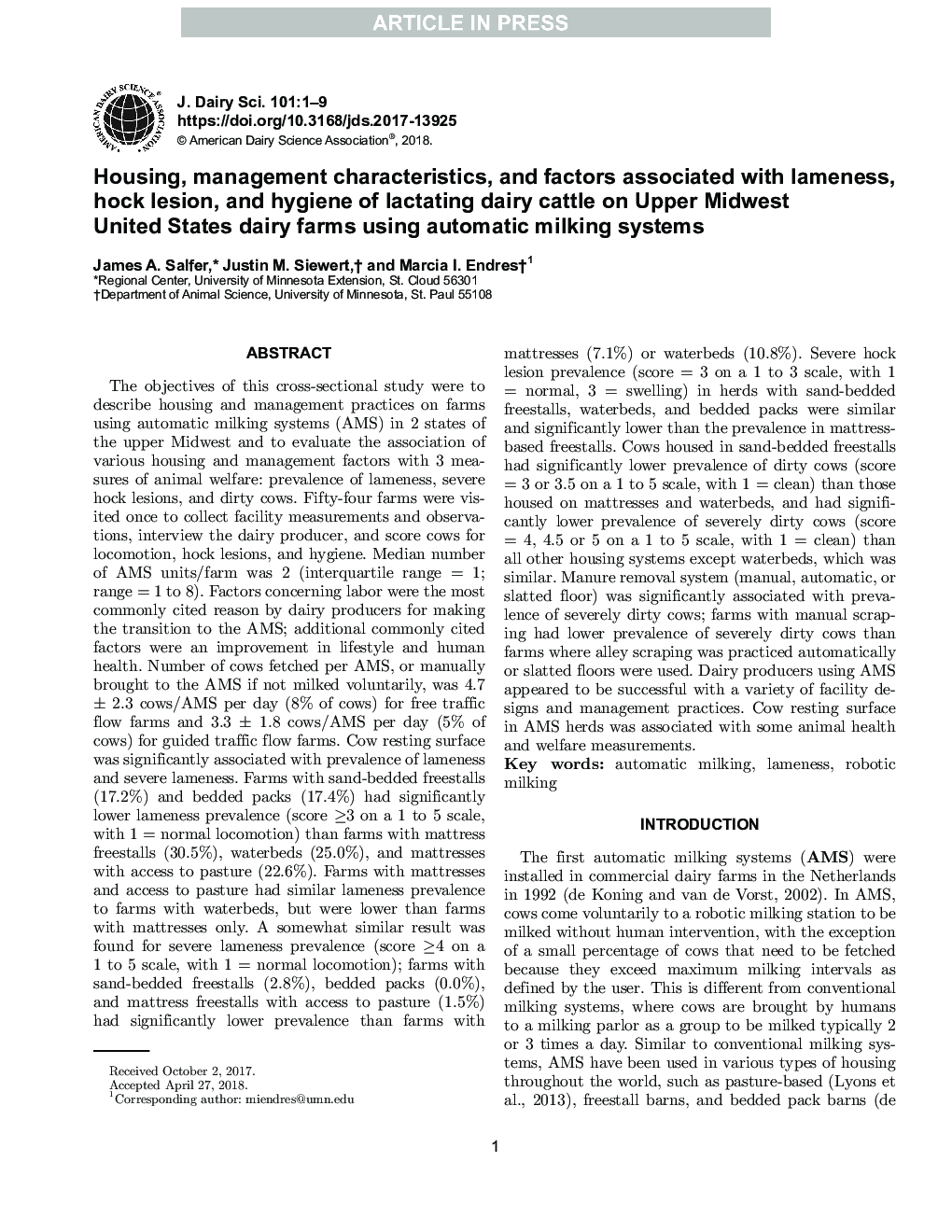| کد مقاله | کد نشریه | سال انتشار | مقاله انگلیسی | نسخه تمام متن |
|---|---|---|---|---|
| 8956513 | 1646155 | 2018 | 9 صفحه PDF | دانلود رایگان |
عنوان انگلیسی مقاله ISI
Housing, management characteristics, and factors associated with lameness, hock lesion, and hygiene of lactating dairy cattle on Upper Midwest United States dairy farms using automatic milking systems
ترجمه فارسی عنوان
مسکن، ویژگی های مدیریتی، و عوامل مرتبط با لنگش، ضایعه ضعیف و بهداشت دهان شیرده شیرده در مزارع پرورش دهندگان ایالات متحده آمریکا با استفاده از سیستم های شیری اتوماتیک
دانلود مقاله + سفارش ترجمه
دانلود مقاله ISI انگلیسی
رایگان برای ایرانیان
کلمات کلیدی
دوش اتوماتیک، لنگش شیردوشی رباتیک،
موضوعات مرتبط
علوم زیستی و بیوفناوری
علوم کشاورزی و بیولوژیک
علوم دامی و جانورشناسی
چکیده انگلیسی
The objectives of this cross-sectional study were to describe housing and management practices on farms using automatic milking systems (AMS) in 2 states of the upper Midwest and to evaluate the association of various housing and management factors with 3 measures of animal welfare: prevalence of lameness, severe hock lesions, and dirty cows. Fifty-four farms were visited once to collect facility measurements and observations, interview the dairy producer, and score cows for locomotion, hock lesions, and hygiene. Median number of AMS units/farm was 2 (interquartile range = 1; range = 1 to 8). Factors concerning labor were the most commonly cited reason by dairy producers for making the transition to the AMS; additional commonly cited factors were an improvement in lifestyle and human health. Number of cows fetched per AMS, or manually brought to the AMS if not milked voluntarily, was 4.7 ± 2.3 cows/AMS per day (8% of cows) for free traffic flow farms and 3.3 ± 1.8 cows/AMS per day (5% of cows) for guided traffic flow farms. Cow resting surface was significantly associated with prevalence of lameness and severe lameness. Farms with sand-bedded freestalls (17.2%) and bedded packs (17.4%) had significantly lower lameness prevalence (score â¥3 on a 1 to 5 scale, with 1 = normal locomotion) than farms with mattress freestalls (30.5%), waterbeds (25.0%), and mattresses with access to pasture (22.6%). Farms with mattresses and access to pasture had similar lameness prevalence to farms with waterbeds, but were lower than farms with mattresses only. A somewhat similar result was found for severe lameness prevalence (score â¥4 on a 1 to 5 scale, with 1 = normal locomotion); farms with sand-bedded freestalls (2.8%), bedded packs (0.0%), and mattress freestalls with access to pasture (1.5%) had significantly lower prevalence than farms with mattresses (7.1%) or waterbeds (10.8%). Severe hock lesion prevalence (score = 3 on a 1 to 3 scale, with 1 = normal, 3 = swelling) in herds with sand-bedded freestalls, waterbeds, and bedded packs were similar and significantly lower than the prevalence in mattress-based freestalls. Cows housed in sand-bedded freestalls had significantly lower prevalence of dirty cows (score = 3 or 3.5 on a 1 to 5 scale, with 1 = clean) than those housed on mattresses and waterbeds, and had significantly lower prevalence of severely dirty cows (score = 4, 4.5 or 5 on a 1 to 5 scale, with 1 = clean) than all other housing systems except waterbeds, which was similar. Manure removal system (manual, automatic, or slatted floor) was significantly associated with prevalence of severely dirty cows; farms with manual scraping had lower prevalence of severely dirty cows than farms where alley scraping was practiced automatically or slatted floors were used. Dairy producers using AMS appeared to be successful with a variety of facility designs and management practices. Cow resting surface in AMS herds was associated with some animal health and welfare measurements.
ناشر
Database: Elsevier - ScienceDirect (ساینس دایرکت)
Journal: Journal of Dairy Science - Volume 101, Issue 9, September 2018, Pages 8586-8594
Journal: Journal of Dairy Science - Volume 101, Issue 9, September 2018, Pages 8586-8594
نویسندگان
James A. Salfer, Justin M. Siewert, Marcia I. Endres,
